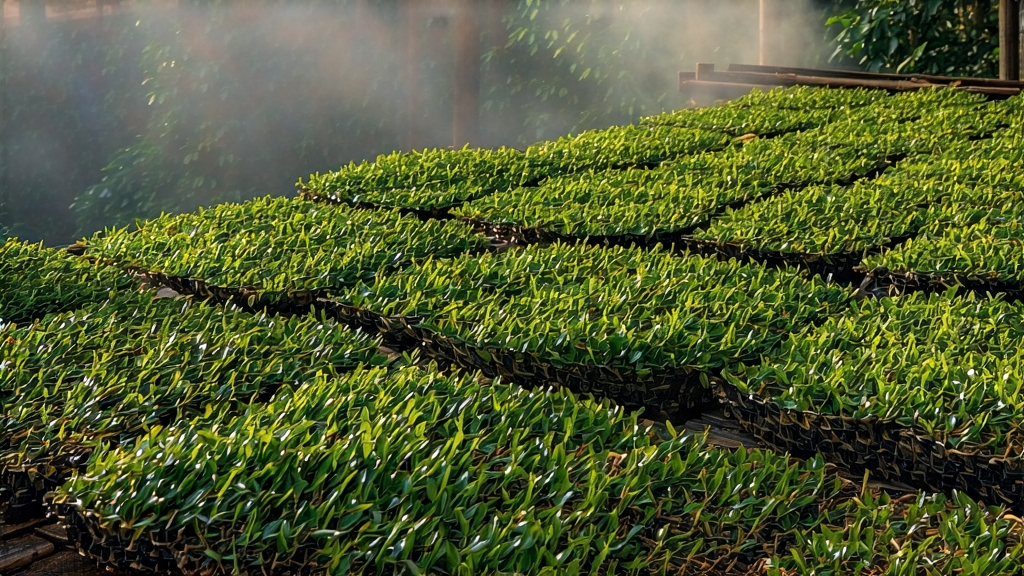
Long before English breakfast blends and Assam estates, the first fully oxidized leaf that would inspire the world’s black teas emerged from the granite gorges of the Wuyi Mountains in China’s Fujian Province. Locals call it Zheng Shan Xiao Zhong—“small leaf from the original mountain”—but the West knows it as Lapsang Souchong, the primordial campfire aroma that once perfumed the parlors of London and St. Petersburg. Its story begins in the late Ming dynasty, when retreating imperial armies forced tea farmers to hastily dry their harvest over fresh pine boughs to meet the Qing army’s sudden demand for provisions. The accidental smoke transformed the leaf, preserved it against the damp mountain air, and created a flavor so arresting that Dutch traders carried it to Europe in 1604, launching the first global craze for black tea.
Geography is the first secret. Only leaves plucked within the 600-square-kilometer core of the Wuyi Nature Reserve—where mist rises from the Jiuqu (“Nine Bends”) Stream and Jurassic-era cliffs trap cool, mineral air—may bear the name Zheng Shan. The cultivar is a diminutive, slow-growing Camellia sinensis var. sinensis known as Cai Cha, whose leaves are no larger than a sparrow’s tongue yet thicken with polyphenols under the shock of cool nights. At altitudes between 1,200 and 1,500 meters, the bushes root directly into weathered tuff and granite, drawing potassium and manganese that later translate into a sweet, stony finish in the cup.
Two distinct styles survive today. The traditional pine-smoked version, Wu Xiong Xiao Zhong, is still crafted in the three original villages of Tongmu, Guadun, and Miaowan. A newer, unsmoked style called Zheng Shan Xiao Zhong (sometimes marketed as “Wild Lapsang”) omits the final firing over pine, allowing the natural honey, longan, and alpine flower notes to dominate. Both share the same four-step withering-rolling-oxidation-firing sequence, yet diverge at the critical moment when smoke meets leaf.
Craft begins at dusk. Freshly picked two-leaf-and-a-bud flushes are loaded onto bamboo trays set above shallow trenches of damp pine and cypress embers. For eighteen hours the leaf rests in this warm haze, losing 60 % of its moisture while absorbing α-pinene and creosol that will later evoke smoked apricot and resinous incense. Master smokers gauge the fire by ear: when the pine logs pop like distant firecrackers, the temperature hovers at the ideal 80 °C. Too hot and the leaf chars, too cool and the aroma turns musty. Once the leaf twists into a glossy, ebony strip, it is rolled under low pressure to rupture cell walls, then oxidized for three hours in cedar-lined trays. The final charcoal-pine firing lasts only minutes, but the memory of smoke lingers for years if the tea is stored away from light and moisture.
To brew Lapsang Souchong gongfu style, use a small Yixing zisha pot or a gaiwan of 120 ml. Heat the vessel with 95 °C water, then fill one-third with leaf—about five grams. The first flash infusion, ten seconds, releases a liquor the color of late-autumn sherry and an aroma that marries lapsang’s signature pine-smoke with the unexpected sweetness of dried longan. Subsequent steeps lengthen by five-second increments; the fifth infusion often reveals a cocoa-butter texture and a cooling camphor note that echoes the fir forests outside the factory window. Western drinkers may prefer two grams per 250 ml mug and a three-minute infusion, but the gongfu method exposes the tea’s architectural layers: smoke first, then fruit, then mineral, then a lingering floral echo that perfumer Luca Turin once compared to “linden blooming in a bonfire.”
Tasting notes are best mapped on a flavor wheel drawn from Wuyi terroir. At the center sits pine resin, radiating outward into dried apricot, toasted almond, and the wet-stone minerality that Chinese cuppers call yan yun—“rock rhyme.” A high-grade Tongmu will finish with a cooling sensation at the back of the throat, a sign of amino-acid-rich leaf grown on shaded northern slopes